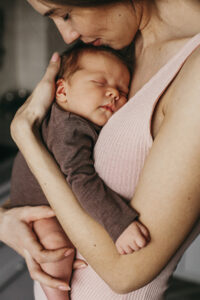 Responsive feeding involves responding you your baby’s cues for food, comfort and reassurance rather than following a set routine or schedule.
Responsive feeding involves responding you your baby’s cues for food, comfort and reassurance rather than following a set routine or schedule.
By letting your baby feed when they need to, you’ll make sure they receive the milk they need when they need it. It will also stimulate your milk supply. It also means looking after your own needs too. You might want to feed your baby if your breasts are uncomfortably full, or if you need to fit in a feed. Breastfeeding your baby when you just want to spend time together and bond is responsive feeding too, so do this as often as feels right for you and your baby.
Why is ‘responsive feeding’ important for my baby?
 Your newborn baby’s tummy is roughly the size of a cherry and can hold about 5ml of milk. This means your newborn will need to feed little and often. As breastmilk is easily digested, your baby can be hungry again soon after a feed. This is why ‘responsive feeding’ is so important.
Your newborn baby’s tummy is roughly the size of a cherry and can hold about 5ml of milk. This means your newborn will need to feed little and often. As breastmilk is easily digested, your baby can be hungry again soon after a feed. This is why ‘responsive feeding’ is so important.
Signs of hunger
Starting with a calm baby is the best way to feed.
 People often think crying is the first sign a baby is hungry. In fact, crying is the last cue your baby will use to tell you they need a feed. If you wait for crying it can be more difficult for your baby to latch. Give your baby a cuddle and try to calm them down before you try to latch them on again.
People often think crying is the first sign a baby is hungry. In fact, crying is the last cue your baby will use to tell you they need a feed. If you wait for crying it can be more difficult for your baby to latch. Give your baby a cuddle and try to calm them down before you try to latch them on again.
Early hunger cues:
 mouth opening
mouth opening- stirring from sleep
- turning their head to find milk
- hands to mouth
- stretching
- increased movements.
Early days
- Feeding your baby responsively
- Breastfeeding after a c-section
- If your baby arrives early or unwell
- How do I get my baby attached and feeding effectively?
- How can I tell if it's going well
- Bottle feeding and other ways to feed your baby
- What can partners or others do to help (instead of giving a bottle)
- Why am I finding it painful?
